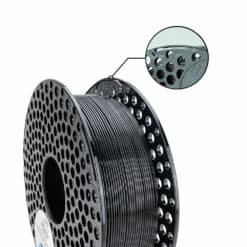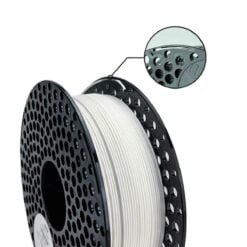PC ABS
PC ABS filament White is an incredibly strong automotive-grade material perfect for mechanical parts and technical applications. The addition of polycarbonate (PC) to acrylonitrile butadiene styrene (ABS) creates a material that prints smoothly with nearly perfect interlayer adhesion. The end result is a high-quality print that is lightweight, durable, and has a smooth surface gloss.
To know more about PC ABS filaments, read our blog.
Printing recommendations:*
- For the best results, print at 265–285°C.
- Recommended printing bed temperature is 110°C. This material needs to be printed with an enclosed 3D printer.
*Ideal temperature may vary when using different printers.
Applications
PC ABS filament is highly valued in the 3D printing industry for its unique combination of toughness, high heat resistance (up to 122°C), and ease of printing.

Functional prototypes
PC ABS is widely used for creating functional prototypes that need to withstand rigorous testing and evaluation. Functional prototyping is a critical step in the development process across various industries, providing valuable insights into how the final product will perform under real-world conditions, as well as allowing for design adjustment and improvements. Automotive components such as venting systems, dashboard prototypes and door handles can be 3D printed with PC ABS to fully test their performance under conditions such as mechanical stress and exposure to high temperatures.
Consumer product components
Due to the excellent durability and strength of PC ABS, it is used to 3D print end-use parts for a wide range of consumer products. For example, PC ABS is used to print custom enclosers for electronic devices such as handheld devices (smartphones, tablets) and drones. PC ABS’s formidable heat and impact resistance ensure the electronics enclosed are protected in various environments.
Custom components for manufacturing
PC ABS’s versatility makes it ideal for producing custom fixtures, jigs and other components used in manufacturing processes. This can include tooling, assembly aids, and custom mounts that need to be durable and resistant to industrial environments.
Product storage
We recommend storing the filament in a cool, dry enclosed space with a silica desiccant packet, away from UV light.
Features & properties
| Feature | Standard | XY Value | XZ Value | ZX Value | Unit |
|---|---|---|---|---|---|
| Tensile Strength | ISO 527-2 | 41.4 | 42.7 | 18.3 | MPa |
| Yield Strength | ISO 527-2 | 33.3 | 32.8 | / | MPa |
| Tensile Modulus | ISO 527-2 | 2000 | 2000 | 1800 | MPa |
| Strain at Yield | ISO 527-2 | 5.3 | 4.0 | 1.2 | % |
| Flexural Strength | ISO 178 | 65.7 | 67.0 | 26.8 | MPa |
| Flexural Modus | ISO 178 | 2100 | 2200 | 1900 | MPa |
| Impact Strength | ISO 179 | 25 | / | / | kJ/m² |
You can access the Technical Data Sheet and Safety Data Sheet here.






















